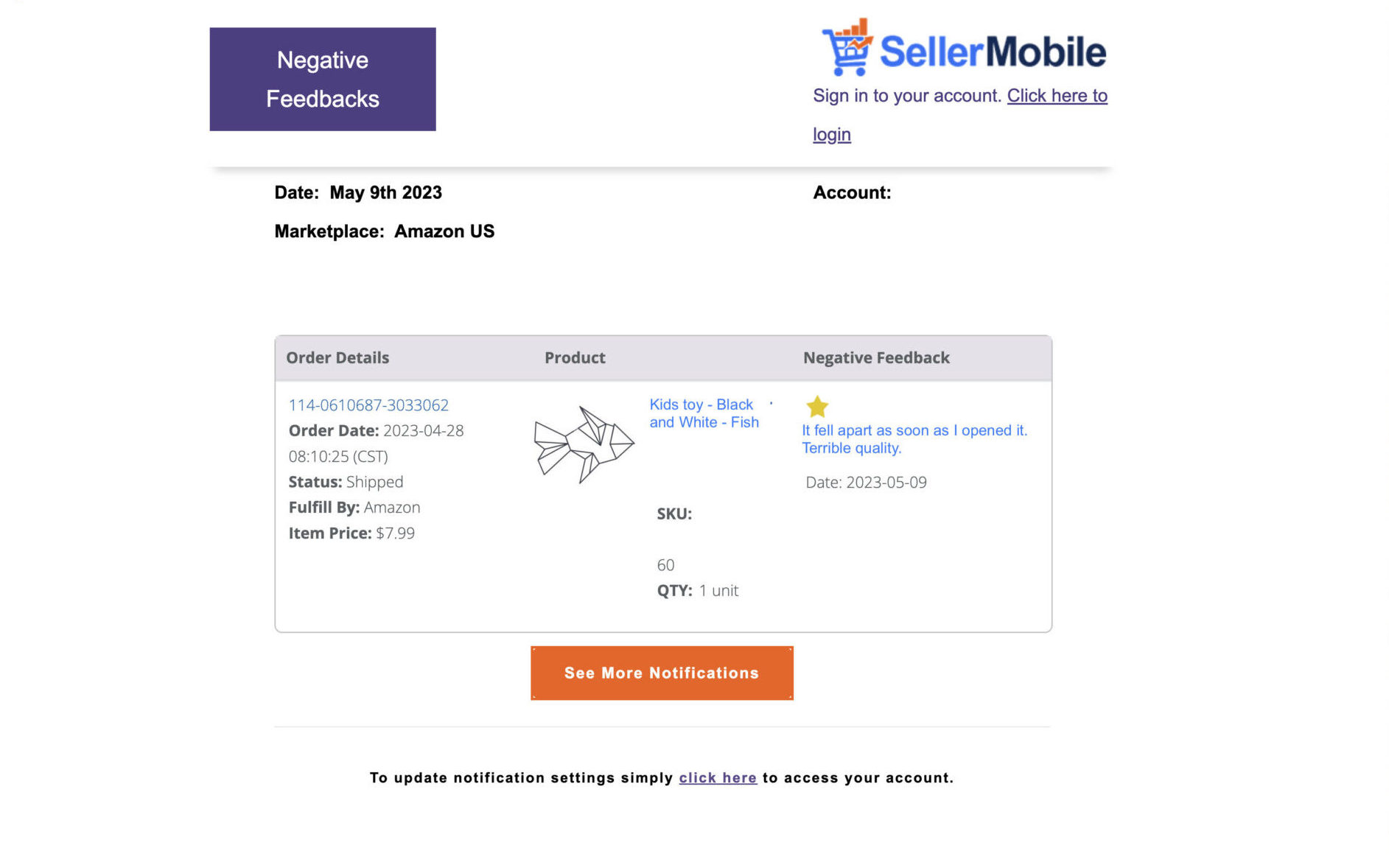You do everything to make the purchase happen – optimize product descriptions, invest more in ads, and hundreds of other efforts…
But what happens after the purchase is just as important (if not more) as what came before.
If your orders reach the customers with defects or something in the shipping process goes wrong, and your Amazon customers don’t get what they expected, your hard work and investment are in vain.
Your customers would express their dissatisfaction. They might claim a refund or leave negative feedback.
In either case, they will push your Amazon order defect rate up.
Read on to learn how not to let it happen.
What Is Order Defect Rate on Amazon?
Amazon ODR is one of the key metrics telling Amazon how well you do your job as a seller. It shows the percentage of the defective orders you sent out of the total number of delivered orders during 60 days.
A “defective” means different things here.
- You might’ve shipped a damaged item.
- Your shipped item might differ from what the customer ordered.
- The delivery might’ve been delayed.
- The customer might need better customer service.
In short, anything unsatisfying or wrong for your customers will be counted as a defective order and added to your Amazon order defect rate.

And this will signal to Amazon that your store is not reliable and trustworthy. In the long run, it may lead to Suspension or even termination of your account.
How Does Amazon Calculate the Order Defect Rate?
Amazon monitors which part of your total shipped items get returned and which customers leave negative feedback. In the mathematical formula, it looks like this.

Amazon calculates this metric considering your performance during 30 days to be objective and give you enough time to fix the issues.
There are four key things you need to know about the ODR Amazon calculation.
- Several negative signals from the same customer on the same order will be calculated as one defect. Let’s say a customer left a bad review and requested a refund. For Amazon, that’s not two defects but one.
- Any claim from the customer who received your item will be included in your ODR calculation. Even if you solved the issue and the customer withdrew the claim, it will still raise your ODR.
- Rating reports are withheld until 30 and can reach 90 days. That’s again Amazon’s attempt to assess your performance objectively and give you some time to solve the issue.
- Don’t get discouraged or worried if one of your items, or even several of them, is defective. Amazon will imply a penalty only if you exceed the 1% threshold and fail to recover the situation within the given period.
So, things are pretty objective here.
If you made a mistake (who doesn’t) but worked hard to fix it, you can continue to sell on Amazon with no problem.
But if defective orders are too many and this continues for a long time, you need a serious action plan to reduce the defect rate. And Amazon thinks you need to be temporarily suspended from their platform.
What Factors Contribute to Order Defect Rate on Amazon?

Well, the customer is dissatisfied. What should happen for Amazon to notice that? Which customer activities signal Amazon that something is wrong?
These are the key factors contributing to your Amazon seller order defect rate.
Credit Card Chargeback
Whenever a customer that purchased something from you requests Amazon to return the charged amount to their credit card, there are two outcomes.

In one scenario, Amazon investigates the issue and realizes the chargeback is fraudulent (the customer received the quality item but tries to get a refund anyway). In that case, your Amazon ODR is unchanged because that’s not your fault.
In the second case, Amazon finds out the chargeback is requested because of the poor quality of an item or customer service. Consequently, this case adds up to your ODR.
A-to-Z Guarantee
This is a customer protection program designed for those buyers who have ordered an item and weren’t satisfied with it. So, Amazon customers can get a full refund of their paid money in some cases.
- The product hasn’t arrived within the maximum estimated delivery date
- The product differs from the description/image presented in the seller’s listings.
The A-to-Z guarantee claimed by the customer can affect your Amazon ODR score or not, depending on how Amazon assesses the case.
If the claim falls under Process for Property Damage and Personal Injury or Amazon finds out you’re not responsible for the defective item, your ODR will remain unchanged. Otherwise, it’s an additional defect to consider.
Negative Feedback
Lastly, if you get 1-2 starts from a customer who has ordered a product from you, Amazon flags that as a defect. To be objective, it calculates the negative feedback ratio, which is the total number of 1-2 stars reviews divided by the total number of orders within a given period.

So, if your feedback is predominantly positive and there are only a few 1-2 star reviews, Amazon won’t count those against you.
However, whenever you get a negative review on Amazon, rush to find out why and solve the customer’s issue. Politely ask your customer to change their review if you feel that’s achievable.
How Do I Find Order Defect Rate Amazon?
Your Seller Central account calculates and displays your Amazon order defect rate.
- Head to the “Performance” tab in your Seller Central dashboard.
- Choose “Account Health“.
- Click “View Details” in the “Customer Service Performance” section.
You can then view and download your latest ODR report and derive insights from it to improve your Amazon seller account’s health.

There is also an option to turn on notifications whenever your ODR passes the acceptable threshold. This simplifies the process of staying on top of your account issues.

What Is the Maximum Order Defect Rate (ODR) Allowed by Amazon for Your Account to Avoid Suspension?
1% is the acceptable ODR threshold. Amazon order defect rate over 1 puts your account at risk.
If your ODR surpasses 1% dramatically, say, it reaches 3% and more, your account can be terminated as Amazon views you as a bad seller who risks the marketplace’s reputation.
If your ODR is slightly above 1%, you will receive warnings in the form of temporary suspensions. You should do your best to recover your ODR as soon as possible to avoid more serious consequences.
If Amazon ODR Goes Above 1%, How Long Do You Have to Get It Under

Whenever the ODR slightly surpasses 1%, Amazon gives you 17 days to come up with an action plan to reduce it. This plan should include the following information.
- The causes of the high ODR. Which issues most often lead to unhappy customers? Is there a clear pattern, or is it random?
- Which actions are you planning to take to reduce the ODR? You should have a clear strategy for improving customer service, product quality, or other issues that lead to customer dissatisfaction.
If, after 17 days, there are no significant improvements, Amazon will suspend your account.
Note! Amazon calculates ODR a month behind to include all the claims and feedback that can indicate customer dissatisfaction.
Rankings in Danger. Why Do You Need to Improve Amazon Order Defect Rate?

Your products’ visibility in search results is directly affected by your ODR score. The lower the ODR, the higher the rankings of your products will be.
Whenever your Amazon order defect rate increases above 1%, Amazon automatically removes your products from Buy Box. This means your products will no longer appear in the bestseller lists, product categories, and on homepages. Competitor products will be promoted instead of yours.
Besides, it would be harder for you to appear in the organic search results of Amazon. All else equal, Amazon will display products with low ODR scores before the ones with high defect rates. This will leave you with fewer chances to attract customers and increase profits.
Amazon is very sensitive to order defect rates. Even if you’re a successful seller on the platform who has turned a few hundred dollars into millions, your Amazon order defect rate mistakes can lead to significant losses.
4 Tactics to Improve Amazon Order Defect Rate
So, how should you keep your order defect rate below the acceptable threshold? Here are the four main tactics that many sellers rely on.
Quickly React to All Negative Reviews
Log in to SellerMobile and sync it with your Amazon Seller Central account to spot negative reviews as they come in. When it comes to Amazon, minutes matter. The sooner you respond to negative reviews, the better your reputation and Amazon order defect rate.
When you’re logged in to SellerMobile, [need SellerMobile’s team instruction on showing how to turn on notifications for bad reviews]
After that, you will be instantly notified about the bad review, whether you’re logged in to the platform or not.

This way, you’ll be able to act quickly and decrease one of the main causes of high ODR.
Be Prepared for Holiday Demand Increase
At the end of 2022, Amazon announced it recorded an all-time highest holiday shopping between Thanksgiving and Cyber Monday. Additionally, all 2022 holiday season sales of Amazon show higher numbers than that of the previous three years.
With these holiday spikes, sellers need to be very well prepared to meet the high demand during the holiday season. Here’s when the risk of delivery delays, wrong items sent out, and all other issues that could lead to customer dissatisfaction is the highest.
Calculating the upcoming demand based on your previous sales history is the best way to prepare for the demand increase. To do that, connect a specialized Amazon sales analytics software – SellerMobile, to your Seller Central account. After that, the software will automatically extract your previous sales data and project future sales based on your performance + other factors such as seasonality.

Further, SellerMobile will translate the forecasted demand into restocking suggestions for you in every detail.
- Which SKUs to order and in which quantities
- When to place the restock order considering supplier lead time so that you receive items just when they’re needed
With this data at hand, you can be well-prepared for holiday demand and surpass competitors in customer satisfaction rates.
Have Good and Reliable Packaging

Though Amazon covers some issues that occurred because of the delivery service provider, ensuring you have proper packaging for the item you send out is very important.
For example, ensure your item is properly encased into the shipping box, not just placed in it. Use two types of filler – one to keep the item in place and the other to fill up the remaining space in the package.
If you sell fragile items, use bubble wrap and other extra packaging materials.
Keep Your Amazon Listings Up-to-Date
Out-of-stock listings are considered one of the most costly seller mistakes on the platform, resulting in an increased Amazon order defect rate. Your listings should only contain items you can send at the moment. So, regularly remove discontinued items from the listings.
These also refer to outdated product descriptions, images, and titles. Ensure that what is written in the description is accurate and true. Customers should receive the item they are expecting to receive.
Conclusion
Unsurprisingly, the eCommerce giant is very sensitive to customer satisfaction. Any issues that cause customer dissatisfaction are quickly spotted and penalized by Amazon. So you need to be aligned with the company’s standards to maintain a good Amazon order defect rate, and specialized Amazon seller analytics software – SellerMobile will help you to achieve that.






